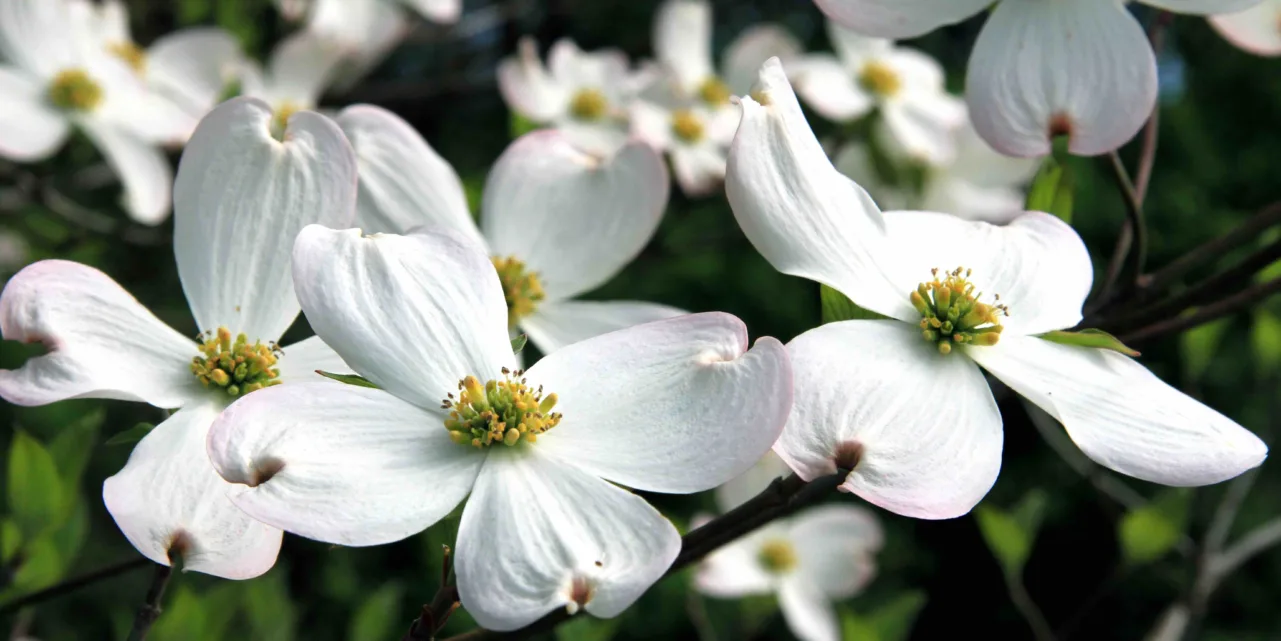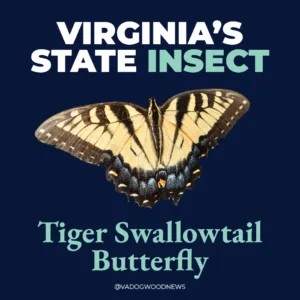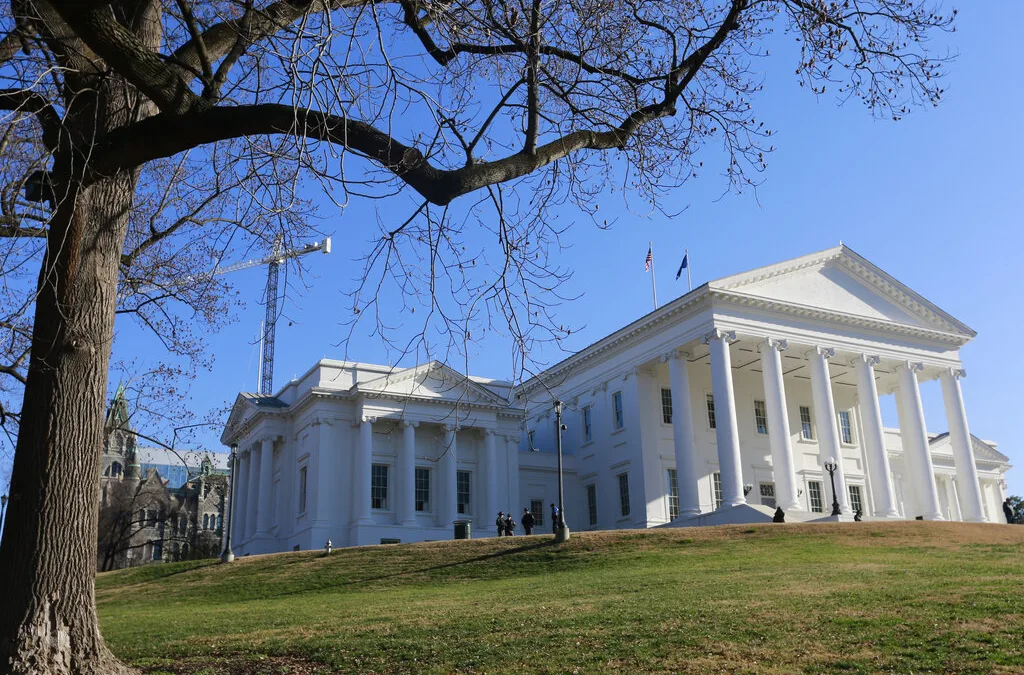
Photo by PeteMuller from Getty Images Signature
Have you ever wondered why the Dogwood is the state flower? Or how the cardinal became the state bird? We’re here to answer those questions and more with a deep-dive into Virginia’s state symbols.
Virginia State Seal

The Virginia State Seal might be one of the most recognizable symbols in the commonwealth. It was first adopted in 1776, 12 years before Virginia even became a state.
The female figure on the seal is the personification of Virtus, the goddess of virtue, standing strong after winning a battle. Underneath her is the personification of Tyranny, which symbolizes the defeat of Great Britain by Virginia, complete with a fallen crown to represent separation from a monarchy.
Virtus is holding two weapons in the seal: A long spear and a sheathed parazonium. The parazonium is also known as the sword of authority, not one of combat. It also features the word “Virginia,” for obvious reasons, but also the Latin phrase “sic semper tyrannis,” which translates into “thus always to tyrants.”
The symbol is prominently featured on the Virginia state flag, making it the only flag in the United States to feature (even partial) nudity as part a state symbol.
Virginia’s State Flower

Fun fact: Virginia’s state flower can be found on its state tree! The flower was a state symbol long before the tree was, and Virginia is the only state to have both the same state flower and state tree.
You’ll probably see this beautiful bloom all throughout Virginia this spring. The large flowers are usually a greenish-white, but it’s not uncommon to see them as pink or yellow.
Virginia’s State Bird

On Jan. 25, 1950, the Northern Cardinal was officially named the Virginia State Bird. Chances are high you’ve spotted these brightly colored birds in your backyard. The species is native to Virginia, going as far back to colonial times, where European settlers noticed that the bird’s vibrant red matched the colors of the robes worn by cardinals in the Catholic Church.
This bird is also the state bird in six other states, including our neighbors Kentucky, North Carolina, and West Virginia. It’s also the state bird in three midwestern states: Illinois, Indiana, and Ohio.
Virginia’s State Tree

No, this isn’t déjà vu. Yes, you just read about the Dogwood was the state flower, and now you’re reading about it as the state tree! The Dogwood designation as the state flower came in 1918, while it was named the state tree in 1956.
Fun fact: Thomas Jefferson grew American Dogwoods on the grounds of his Charlottesville home, Monticello, in the 1770s.
Virginia’s State Dog

In 1966, the American Foxhound barked its way up to top dog in Virginia. In colonial times, the hounds were used for the sport of fox hunting. George Washington was also a fan, having at least 36 of the dogs (including Vulcan the ham-stealer and Drunkard).
The American Foxhound was one of the first recognized dog breeds unique to American soil.
Virginia’s State Shell

In 1974, the Eastern oyster (scientifically known as Crassostrea virginica) offi-SHELL-y became a state symbol.
The mollusk is an important species in the commercial industry, even though it is an incredibly vulnerable species to factors like overfishing, global warming, and water pollution. Despite that, Eastern oysters have fast growth rates and high reproduction rates. Females can produce over 100 million eggs during a spawning event.
Virginia’s State Insect

The Tiger Swallowtail Butterfly was initially suggested to be the state insect back in 1976, but the Virginia House of Delegates wanted the praying mantis to be the official state insect instead. Ultimately, lawmakers came around to adopt the butterfly as Virginia’s state insect 33 years ago.
This butterfly is an easily recognizable state symbol because of its bright colors. Female tiger swallowtails can be yellow and black, like their male counterparts, but they can also be a shadowy black with some pops of blue. It was also the first insect to be scientifically described from North America.
Virginia’s State Freshwater Fish

The brook trout is Virginia’s official freshwater fish, but it didn’t always hold that title. It was first designated the official state fish in 1993, but was later designated the state freshwater fish in 2011.
In the trout family, it’s the most colorful one. They have white bellies with bright orange fins, and are speckled with yellow or red spots that have a blue halo around them. That’s why the species is also known as the speckled trout.
The brook trout lives in cool, clean, and pure water conditions and can be found in many streams and lakes across the commonwealth, provided the water is 68 degrees Fahrenheit or less. Shenandoah National Park is home to many native brook trout, as well as the George Washington and Jefferson National Forest.
Virginia’s State Saltwater Fish

We’re all about the (striped) bass, no treble. Did you know that Virginia didn’t have a designated state saltwater fish until 2011?
The fish, also known as a rockfish, bass, or linesider, can live to be at least 30 years old. It can also grow to over four feet in length! Female striped bass have a tendency to be larger than male striped bass.
Virginia’s State Snake

The reason Virginia has a state snake comes down to one 11-year-old who was on a mission to get the Eastern Garter Snake recognized, with the help of his local state representative. On March 7, 2016, Virginia officially adopted the reptile as a new state symbol.
This danger noodle isn’t actually dangerous; garter snakes are one of the most common snakes to have as a pet. Even though they might look a little scary, they’re harmless and are especially loved by gardeners.
Virginia’s State Rock

2016 “rocked” in Virginia, thanks to a group of students at Piedmont Virginia Community College, who pushed for a state stone. The legislation rolled along thanks to the help of Creigh Deeds.
Senate Bill 352 was signed into law by former Gov. Terry McAuliffe, and not only did it designate Nelsonite as the official state rock of Virginia, but it reinstated the Northern Cardinal as the state bird and the American Dogwood as the state tree; these two symbols had been inadvertently omitted.
The rock was named for Nelson County, and has a longstanding history in the commonwealth. Nelsonite was a key economic resource when it was discovered in the early 1900s.
Virginia’s State Pony

The commonwealth’s newest state symbol is the Chincoteague Pony. Thanks to two nearly identical pieces of legislation that passed through the 2023 state House and Senate that were impossible to say “neigh” to, Virginia will became the 18th state to have an official state pony.
You may find this fact cool or disturbing (we seldom see another type of reaction), but visitors to the Museum of Chincoteague can see the real foal from Marguerite Henry’s book, Misty of Chincoteague. The pinto pony’s taxidermy remains are on display.

VIDEO: Your support matters!
Your support matters! Donate today. @vadogwoodnews Your support matters! Visit our link in bio to donate today. #virginianews #virginia #community...

Op-Ed: Virginia’s new Democratic majorities pass key bills to improve your lives, but will Youngkin sign them?
The 2024 Virginia General Assembly regular session has wrapped up. It was a peculiar session from the outset, with Democratic majorities in the...

Op-Ed: Why Virginia Needs A Constitutional Amendment Protecting Reproductive Freedom
Virginia’s recent election season in 2023 drew in eyes from all over the country. Reproductive freedom was on the line and Virginia remained the...

VIDEO: Second-gentleman Douglas Emhoff gives speech on reproductive freedom
Second gentleman, Douglas Emhoff touched on reproductive freedom not only being a woman's issue but "an everyone's issue" during the Biden-Harris...

Glenn Youngkin and the terrible, horrible, no good, very bad night
Election Day 2023 has come and gone, and while there are votes to be counted, one thing is perfectly clear: Virginians unequivocally rejected Gov....

5 unsolved mysteries and true crime tales from Virginia that’ll send chills up your spine
No matter how “safe” a state may be, it inevitably still has a number of unsolved mysteries and true crime tales to tell. Unfortunately, Virginia is...




